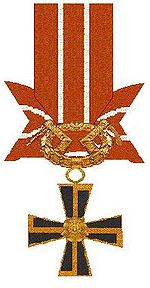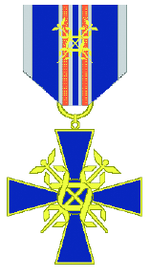- Orders, decorations, and medals of Finland
-
The orders, decorations and medals of Finland form a rather complicated system through which the Finnish government shows its respect to persons who have distinguished themselves on some walk of life. The legal basis of the system is the Act on the displays of public recognition (1215/1999) which grants the president the authority to issue decrees on orders, medals and titles.
The system is divided into three groups:
- orders
- medals and decorations
- titles
Contents
Orders
There are three Finnish orders:
- The Order of the Cross of Liberty, founded in 1918
- The Order of the White Rose of Finland, founded in 1919
- The Order of the Lion of Finland, founded in 1941
The President of Finland is the grand master of all orders. Of the orders, the Order of the Cross of Liberty is the most distinguished and awarded the most seldom. Its decorations are awarded only for military or national defence merits. The other two crosses are awarded both for civilians and military persons. The decorations are awarded twice a year, on 4th June on the Flag Day of the Finnish Defence Forces, and on the Independence day, 6th December. In total, there are about 6.000 awards a year.
The orders of the White Rose and the Lion of Finland have a common board and chancellor, while the Order of the Cross of Liberty has a separate board and chancellor. All orders are awarded by the president of Finland.
Medals and decorations
The individual areas of government have usually a separate awards system designed to show respect for those persons who do not qualify for an order. Such medals are founded by a presidential decree. Most typically, they include one or two classes: a cross and a medal. Thus far, the following medals have been founded [1]
- The medal of merit of motor transport
- The medals of merit of customs service
- The crosses and medals of merit of Finnish sports and culture of physical exercise
- The Olympic cross (1st and 2nd class) and medal of merit
- The cross and medals of merit of Finnish Red Cross
- Life saving medal
- The medal of War of Liberation
- The memorial medal of the war of the years 1939-1940
- The memorial medal of the war of the years 1941-1944
- Mine clearance medal
- Medal for human alacrity (Pro Benignitate Humana)
- The cross of merit of the invalids of war
- The cross and medal of merit of police
- The cross and medal of merit of Finnish Border Guard
- The badge of merit of fire prevention
- The 1st and 2nd classes of the medal of merit of civil defence
- The cross of merit of prison service
- The cross of merit of customs service, with or without a clasp
- The military merit medal
- The golden medal of merit of Suomen Reserviupseeriliitto (Finnish reserve officers' association)
- Guild metal of merit
- The cross of merit of Reserviläisliitto – Reservin Aliupseerien Liitto (Reservists' association – Reserve NCOs' association)
- The medal of merit of Insinööriupseeriliitto (Engineer Officers' association)
- The medal of merit of Kadettikunta (Cadet Corps)
- The medal of merit of traffic safety branch
- The special medal of merit of work for working environment
In addition, there is a state decoration for 30 years of service of state. The corresponding decorations of the Central Chamber of Commerce and City of Helsinki the League of Finnish Municipalities are also approved for use with the official decorations.[2] Other decorations of private bodies may only be used privately.
The awarding body of the medals and crosses of merits varies. Although the decorations are founded by the president, the awarding body is usually the chief of the authority in question, i.e. a minister or a high-level civil servant.
Titles
Although a republic, Finland has a tradition of awarding titles for distinguished citizens. The available titles are listed in the Presidential decree on titles (381/2000). The titles are classified in 16 categories of precedence. The two highest titles are valtioneuvos (English: State counsellor) and vuorineuvos (English: Mining Counsellor). The former is usually awarded to most distinguished, retired politicians, while the latter is meant for the CEOs of the largest Finnish companies. Less distinguished titles span different walks of life. Curiosities include liikenneneuvos (English: traffic counsellor), kotiseutuneuvos (English: home district counsellor) and nuorisoasiainneuvos (English: youth affairs counsellor). In total, there are about 100 different titles. A Finnish title is purely honorary, causing no responsibilities and giving no privileges. All Finnish titles are non-hereditary.
Typically, the titles are awarded by the president. There are some exceptions, however. The chief judge of a district court may award the title of herastuomari (English: judge of the county) to a lay judge with a long service.[3] The Evangelical Lutheran Church of Finland and the Finnish Orthodox Church, on the other hand, have the right to award the titles of director cantus and director musices.[4][5] Yearly, the president awards over 200 titles on the advice of the titles' board. The awards take place twice a year: in March and in September.[6]
In addition to honorary titles awarded by the President, certain honorary titles are awarded ex officio to state civil servants in leading positions. For example, the managers or section chiefs of several state research institutes automatically hold the title of professori ("professor"), if they are qualified for tenured faculty position in a university.[7]
A stamp tax is paid for a title. The tax varies with the rank of the title and can be quite substantial for the higher titles. Customarily the organization that proposes the title pays the tax.
See also
Citations
- ^ Ritarikunnat. Muut viralliset kunniamerkit Retrieved 9-6-2004.
- ^ Muut kunnia- ja ansiomerkit. Ritarikunnat. Retrieved 6-9-2006
- ^ Käräjäoikeuslaki (581/1993) (Finnish)
- ^ Kirkkolaki (1054/1993) (Finnish)
- ^ Laki ortodoksisesta kirkkokunnasta (985/2006) (Finnish)
- ^ The whole section is based on The Council of State webpage on titles and its subpages, retrieved 9-6-2007. (Finnish)
- ^ Autio, V.-M. Professorin viran ja arvon kehitys Suomessa. Published in Suomen professorit 1640–2007. Retrieved in 2009-10-01. (Finnish)
State decorations by country Africa FormerAmericas Asia Burma · Cambodia · Republic of China · Hong Kong · Indonesia · Israel · Japan · Macau · Malaysia · North Korea · Pakistan (Civil · Military) · Philippines · Singapore · Sri Lanka · Thailand
FormerEurope Albania · Armenia · Austria · Belarus · Bosnia and Herzegovina · Bulgaria · Croatia · Czech Republic (Civil · Military) · Estonia · Finland · France · Georgia · Germany (Military) · Italy · Lithuania · Luxembourg · Monaco · Montenegro · Netherlands · Norway · Poland · Portugal · Romania · Russia · Serbia · Slovakia · Slovenia · Spain · Sweden · Turkey · United Kingdom · Vatican
FormerOceania FormerCategories:
Wikimedia Foundation. 2010.


